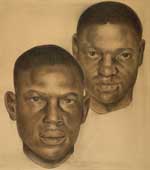The Scottsboro Boys

Patterson / Aaron Douglas /
Pastel on paper, c. 1935 /
National Portrait Gallery, Smithsonian
Institution
This blogpost originally appeared on Feburary 24, 2011
In the long struggle for civil rights and racial equality in America, few episodes had the impact of the infamous Scottsboro Boys case. When nine black teenagers falsely accused of raping two women on a freight train were tried in Scottsboro, Alabama,in 1931, white juries found eight of the nine guilty, and they were sentenced to death.
The widely condemned verdicts and the subsequent reversals, retrials, and hearings—including two successful appeals to the United States Supreme Court—mobilized protests across the country and the world. The International Labor Defense (ILD), the legal arm of the Communist Party, hoping to recruit black workers to their cause, led the defense instead of the more deliberate NAACP. Their involvement rallied protests from whites and minorities alike around the world.
As the nine youths languished in the brutal Alabama prison system, their lives were largely destroyed; together, they spent 130 years in jail, despite the recantation of one of the alleged victims. Clarence Norris (1912–1989) and Haywood Patterson (1913–1952), the subjects portrayed in NPG’s pastel by African American artist Aaron Douglas, were prominent figures in the case. Norris was paroled in 1944 and pardoned by Governor George C. Wallace in 1976; Patterson spent sixteen years in prison and escaped to Michigan in 1948, where the governor refused to extradite him.
Aaron Douglas’s moving portrait (above) provides the opportunity to pair a critical historical story with a powerful work of art. The Kansas-born artist, armed with a BFA from the University of Nebraska, settled in New York City in 1925 and became the leading visual artist for the Harlem Renaissance. After publishing his drawings in Alain Locke’s The New Negro and in national magazines, Douglas illustrated thirteen books by such acclaimed authors as Countee Cullen, Langston Hughes, and James Weldon Johnson. In his illustrations and painted murals, Douglas created new, modernist prototypes to express the African American experience, incorporating influences from Egyptian art, West African sculpture, cubist painting, and Art Deco design.
Ultimately, he became an influential professor at Fisk University. Douglas made this portrait in a more realist manner, avoiding any hint of modernist stylization. His mentor, German artist Winold Reiss, had drawn imposing pastel portraits of Harlem authors. Like Reiss, Douglas focused on the essential humanity and dignity of his subjects.
This drawing was probably made around 1935, when the Supreme Court unanimously overturned the convictions in the Norris and Patterson cases because of Alabama’s exclusion of blacks from the jury rolls. By this time, a one-year fellowship had exposed Douglas to the modern European and African art collected by Albert C. Barnes, and he had spent another year studying in Paris. He was also newly politicized. He had joined the Communist Party in the early 1930s, and as head of the Harlem Artists Guild, he was demanding more black participation in the WPA’s art program.
Douglas was undoubtedly moved by the cover of an ILD pamphlet that featured photographs of Norris and Patterson surrounded by the phrases “save our lives,” “they must not burn,” and “join the fight to free them.” Even more powerful is Douglas’s wordless copy of the two likenesses. The stark, isolated faces, drawn in beautifully blended pastels, mutely confront their audience. The picture speaks to the profound response to this soul-chilling miscarriage of justice and the seriousness of racial prejudice in America.
—Wendy Wick Reaves, Curator or Prints and Drawings, National Portrait Gallery
Further reading: James Goodman, Stories of Scottsboro (New York: Vintage, 1994); Amy Kirschke, Aaron Douglas: Art, Race, and the Harlem Renaissance (Jackson, Miss.: University Press of Mississippi, 1995), and Jim Miller, Moments of Scottsboro: The Scottsboro Case and American Culture (Princeton: Princeton University Press, 2009).